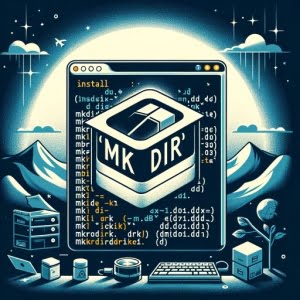Linux Mastery: Installing and Using ‘mkdir’ Command

Struggling with creating directories in Linux? Like a skilled architect, the ‘mkdir’ command in Linux allows you to build new directories with ease. But how do you install and use this command effectively? This might seem a bit complex, especially for Linux beginners. However, mastering the ‘mkdir’ command is definitely worth the effort.
In this guide, we will navigate the process of installing and using the ‘mkdir’ command on your Linux system. We will provide instructions for both APT and YUM-based distributions, such as Debian, Ubuntu, CentOS, and AlmaLinux. We will delve into advanced topics like compiling from source, installing a specific version of the command, and finally, how to use the ‘mkdir’ command and verify the correct version is installed.
So, let’s dive in and start mastering the ‘mkdir’ command in Linux!
TL;DR: How Do I Install and Use the ‘mkdir’ Command in Linux?
In most Linux distributions, the ‘mkdir’ command comes pre-installed, you can verify this with,
mkdir --version. If it is not installed, you can add it via the coreutils package and the command,sudo yum install coreutilsorsudo apt install coreutils. To use it, simply typemkdir directory_namein the terminal, replacing ‘directory_name’ with the name of the directory you want to create.
For example:
mkdir my_directory
# Output:
# A new directory named 'my_directory' is created in the current working directory.
This is just the basic way to use the ‘mkdir’ command in Linux, but there’s much more to learn about creating directories and managing them effectively. Continue reading for more detailed information and advanced usage scenarios.
Table of Contents
- Understanding and Installing the ‘mkdir’ Command in Linux
- Installing ‘mkdir’ Command from Source Code
- Installing Different Versions of ‘mkdir’ Command
- Basic Usage of ‘mkdir’ Command
- Exploring Alternative Methods for Directory Creation in Linux
- Comparing Directory Creation Methods
- Overcoming Challenges with the ‘mkdir’ Command
- Understanding Directory Management in Linux
- The Impact of Directory Management on System Administration and Security
- Wrapping Up: Installing the ‘mkdir’ Command in Linux
Understanding and Installing the ‘mkdir’ Command in Linux
The ‘mkdir’ command in Linux is a fundamental tool for any Linux user. It stands for ‘make directory’, and as the name suggests, it’s used to create directories or folders in your Linux file system. It’s an essential command for organizing your files and maintaining a clean and efficient workspace.
Before we delve into how to use the ‘mkdir’ command, let’s ensure it’s installed in your Linux distribution.
Installing ‘mkdir’ with APT
If you’re using a Debian-based distribution like Ubuntu, you can use the Advanced Package Tool (APT) to install ‘mkdir’. However, it’s worth noting that ‘mkdir’ usually comes pre-installed. You can check if it’s already installed by using the following command:
which mkdir
# Output:
# /bin/mkdir
If it’s installed, this command will output the path to the ‘mkdir’ executable. If nothing is returned, you’ll need to install it. Here’s how:
sudo apt update
sudo apt install coreutils
# Output:
# The 'coreutils' package, which includes 'mkdir', is installed.
Installing ‘mkdir’ with YUM
For CentOS or other Red Hat-based distributions, you can use the Yellowdog Updater, Modified (YUM) to install ‘mkdir’. Similar to APT, you can check if ‘mkdir’ is already installed using the ‘which’ command. If it’s not, you can install it with the following commands:
sudo yum check-update
sudo yum install coreutils
# Output:
# The 'coreutils' package, which includes 'mkdir', is installed.
Installing ‘mkdir’ with Zypper
If you’re using an openSUSE distribution, you can use the Zypper package manager to install ‘mkdir’. The process is similar to the previous methods:
sudo zypper refresh
sudo zypper install coreutils
# Output:
# The 'coreutils' package, which includes 'mkdir', is installed.
Now that we’ve installed ‘mkdir’, let’s explore how to use it to create directories in Linux.
Installing ‘mkdir’ Command from Source Code
If you want to have the latest features or need a specific version of ‘mkdir’ not provided by your package manager, you can compile it from source code. Here is a basic example of how you can do this:
wget http://ftp.gnu.org/gnu/coreutils/coreutils-8.32.tar.xz
tar xvJf coreutils-8.32.tar.xz
cd coreutils-8.32
./configure --prefix=/usr/local
make
sudo make install
# Output:
# The 'mkdir' command from the 'coreutils' package version 8.32 is installed.
This will download the source code for the ‘coreutils’ package, which includes ‘mkdir’, extract it, configure the installation parameters, compile the code, and finally install it.
Installing Different Versions of ‘mkdir’ Command
From Source Code
To install a different version of ‘mkdir’ from source code, you just need to replace ‘8.32’ with the version number you want in the ‘wget’ command.
Using Package Managers
APT
To install a specific version of ‘mkdir’ using APT, you can use the following command:
sudo apt-get install coreutils=version
# Replace 'version' with the version number.
YUM
For YUM, you can use the following command:
sudo yum downgrade coreutils-version
# Replace 'version' with the version number.
Version Comparison
| Version | Key Changes or Features | Compatibility |
|---|---|---|
| 8.32 | Latest features | Compatible with most modern Linux distributions |
| 8.31 | Previous stable release | Compatible with older Linux distributions |
| 8.30 | Older version with long-term support | Compatible with very old Linux distributions |
Basic Usage of ‘mkdir’ Command
Creating Directories
Once you’ve installed ‘mkdir’, you can start creating directories. Here’s how to create a single directory:
mkdir NewDirectory
# Output:
# A new directory named 'NewDirectory' is created.
Verifying Installation
You can verify that ‘mkdir’ is installed and working correctly by checking its version. This can be done with the ‘–version’ option:
mkdir --version
# Output:
# mkdir (GNU coreutils) 8.32
This will display the version of ‘mkdir’ that’s currently installed on your system, confirming that the installation was successful.
Exploring Alternative Methods for Directory Creation in Linux
While ‘mkdir’ is the standard command for creating directories in Linux, there are other methods you can use. In this section, we’ll discuss two alternative approaches: using the ‘touch’ command and manual directory creation.
Creating Directories with the ‘touch’ Command
The ‘touch’ command in Linux is typically used to create empty files. However, with a little creativity, it can also be used to create directories. Here’s how:
touch NewFile && mkdir $(basename NewFile)
rm NewFile
# Output:
# A new directory named 'NewFile' is created.
In this command, ‘touch NewFile’ creates a new empty file named ‘NewFile’. The ‘mkdir $(basename NewFile)’ command then creates a new directory with the same name as the file. Finally, ‘rm NewFile’ removes the empty file, leaving only the directory.
This method can be useful when you need to create a directory and a file with the same name. However, it’s more complex and less intuitive than using ‘mkdir’, so it’s generally recommended to stick with ‘mkdir’ for directory creation.
Manual Directory Creation
You can also create directories manually using a file manager. This is the most intuitive method, especially for those who are more comfortable with graphical interfaces than command line interfaces.
In your file manager, navigate to the location where you want to create the new directory. Right-click in the empty space and select ‘Create new folder’ or ‘Create new directory’. Enter the name of the new directory and press Enter.
While this method is easy and intuitive, it’s less efficient than using the command line, especially when creating multiple directories or scripting.
Comparing Directory Creation Methods
| Method | Advantages | Disadvantages |
|---|---|---|
| ‘mkdir’ command | Fast, efficient, scriptable | Requires command line knowledge |
| ‘touch’ command | Can create file and directory with same name | Less intuitive, more complex |
| Manual creation | Intuitive, no command line knowledge required | Less efficient, not scriptable |
In conclusion, while there are several methods to create directories in Linux, the ‘mkdir’ command is the most efficient and versatile. It’s worth taking the time to master ‘mkdir’, but it’s also useful to know about alternative methods.
Overcoming Challenges with the ‘mkdir’ Command
While the ‘mkdir’ command is generally straightforward to use, you may encounter some common issues. Let’s discuss these challenges and how to resolve them.
Directory Already Exists
One common issue is trying to create a directory that already exists. This will result in an error message:
mkdir ExistingDirectory
# Output:
# mkdir: cannot create directory ‘ExistingDirectory’: File exists
To avoid this error, you can use the ‘-p’ option, which will create the directory if it doesn’t exist and do nothing if it does:
mkdir -p ExistingDirectory
# Output:
# No error message. The directory is created if it doesn't exist.
Insufficient Permissions
Another common issue is trying to create a directory in a location where you don’t have write permissions. This will also result in an error message:
mkdir /root/NewDirectory
# Output:
# mkdir: cannot create directory ‘/root/NewDirectory’: Permission denied
To resolve this issue, you can use the ‘sudo’ command to run ‘mkdir’ with root permissions:
sudo mkdir /root/NewDirectory
# Output:
# The directory is created. No error message.
Remember to use ‘sudo’ carefully, as it allows you to make critical changes to your system.
Invalid Characters in Directory Name
Linux has certain restrictions on what characters can be used in directory names. For example, the slash (/) character is used to separate directories and cannot be used in a directory name. Trying to create a directory with a slash in its name will result in an error:
mkdir New/Directory
# Output:
# mkdir: cannot create directory ‘New/Directory’: No such file or directory
To resolve this issue, replace the slash with a valid character or use an underscore (_):
mkdir New_Directory
# Output:
# A new directory named 'New_Directory' is created.
In conclusion, while the ‘mkdir’ command is generally easy to use, understanding these common issues and their solutions can help you use it more effectively.
Understanding Directory Management in Linux
Directory management in Linux is a fundamental aspect of system administration. Directories, also known as folders in some operating systems, are used to organize files in a hierarchical structure. This organization is crucial in maintaining an efficient and clean workspace.
Importance of Directory Management
Directories provide a way to group related files and directories together, which makes it easier to find, access, and manage files. Without directories, all files would be located in the same place, making it difficult to keep track of them.
ls /home/user
# Output:
# Documents Downloads Pictures Videos
In the above example, the ‘ls’ command is used to list the contents of the ‘/home/user’ directory. The output shows four directories: ‘Documents’, ‘Downloads’, ‘Pictures’, and ‘Videos’. Each of these directories can contain files and other directories, allowing for a structured and organized file system.
The Role of the ‘mkdir’ Command
The ‘mkdir’ command plays a crucial role in directory management in Linux. It allows you to create new directories, which can then be used to store and organize files. Without the ‘mkdir’ command, you would need to use more complex methods to create directories, such as using a file manager or other commands.
mkdir /home/user/NewDirectory
ls /home/user
# Output:
# Documents Downloads Pictures Videos NewDirectory
In this example, the ‘mkdir’ command is used to create a new directory named ‘NewDirectory’ in the ‘/home/user’ directory. The ‘ls’ command is then used to list the contents of the ‘/home/user’ directory. The output shows that the ‘NewDirectory’ directory has been successfully created.
In summary, understanding directory management and the role of the ‘mkdir’ command in Linux is essential for effective system administration. By mastering the ‘mkdir’ command, you can easily create and manage directories in your Linux system, leading to a more organized and efficient workspace.
The Impact of Directory Management on System Administration and Security
Directory management in Linux is not just about organizing files and folders. It also plays a vital role in system administration and security. By properly managing directories, administrators can ensure that system operations run smoothly and that sensitive data is protected.
The Role of Directory Permissions
Directory permissions in Linux control who can read, write, and execute files in a directory. They are a crucial aspect of Linux security and play a significant role in preventing unauthorized access to sensitive data.
ls -l /home/user
# Output:
# drwxr-xr-x 2 user user 4096 Jan 1 00:00 NewDirectory
In this example, the ‘ls -l’ command is used to display the permissions of the ‘NewDirectory’ directory. The ‘drwxr-xr-x’ string represents the directory’s permissions. The first character ‘d’ indicates that this is a directory. The next three characters ‘rwx’ represent the owner’s permissions (read, write, and execute). The next three ‘r-x’ are the group’s permissions (read and execute), and the final three ‘r-x’ are the permissions for others (read and execute).
Understanding Directory Ownership
Directory ownership in Linux determines who has control over a directory and its contents. The owner of a directory can change its permissions, move it, delete it, and perform other administrative tasks.
chown newuser /home/user/NewDirectory
ls -l /home/user
# Output:
# drwxr-xr-x 2 newuser user 4096 Jan 1 00:00 NewDirectory
In this example, the ‘chown’ command is used to change the owner of the ‘NewDirectory’ directory to ‘newuser’. The ‘ls -l’ command is then used to display the new ownership of the directory.
Further Resources for Linux Directory Mastery
To deepen your understanding of directory management in Linux, consider exploring the following resources:
- GNU Coreutils Manual: This manual provides comprehensive information about the ‘mkdir’ command and other GNU core utilities.
The Linux Documentation Project: This project offers a wide range of guides and tutorials on various Linux topics, including directory management and permissions.
Linux Command Library: This library provides a collection of Linux commands, including ‘mkdir’, with detailed explanations and examples.
By exploring these resources and practicing the commands and concepts discussed in this guide, you can become proficient in Linux directory management, enhancing your system administration and security skills.
Wrapping Up: Installing the ‘mkdir’ Command in Linux
In this comprehensive guide, we’ve delved into the process of installing and using the ‘mkdir’ command in Linux, a fundamental tool for directory management. We’ve explored how to install ‘mkdir’ using package managers like APT and YUM, as well as from source code for those needing specific versions.
We began with the basics, providing a step-by-step guide on how to install and use ‘mkdir’ in Linux. We then delved into more advanced topics, discussing how to install ‘mkdir’ from source code, install specific versions, and verify the installation.
Along the way, we tackled common challenges you might encounter when using ‘mkdir’, such as directory already exists, insufficient permissions, and invalid characters in directory names. We provided solutions and tips to help you overcome these hurdles and use ‘mkdir’ effectively.
We also looked at alternative methods for directory creation in Linux, such as using the ‘touch’ command and manual directory creation, giving you a broader perspective on directory management.
Here’s a quick comparison of the methods we’ve discussed:
| Method | Pros | Cons |
|---|---|---|
| ‘mkdir’ command | Fast, efficient, scriptable | Requires command line knowledge |
| ‘touch’ command | Can create file and directory with same name | Less intuitive, more complex |
| Manual creation | Intuitive, no command line knowledge required | Less efficient, not scriptable |
Whether you’re a Linux beginner or an experienced system administrator, understanding how to use the ‘mkdir’ command is essential for effective directory management. We hope this guide has provided you with a deeper understanding of the ‘mkdir’ command and its role in Linux system administration.
Now that you’ve mastered the ‘mkdir’ command, you’re well-equipped to create and manage directories in Linux efficiently and effectively. Happy coding!

